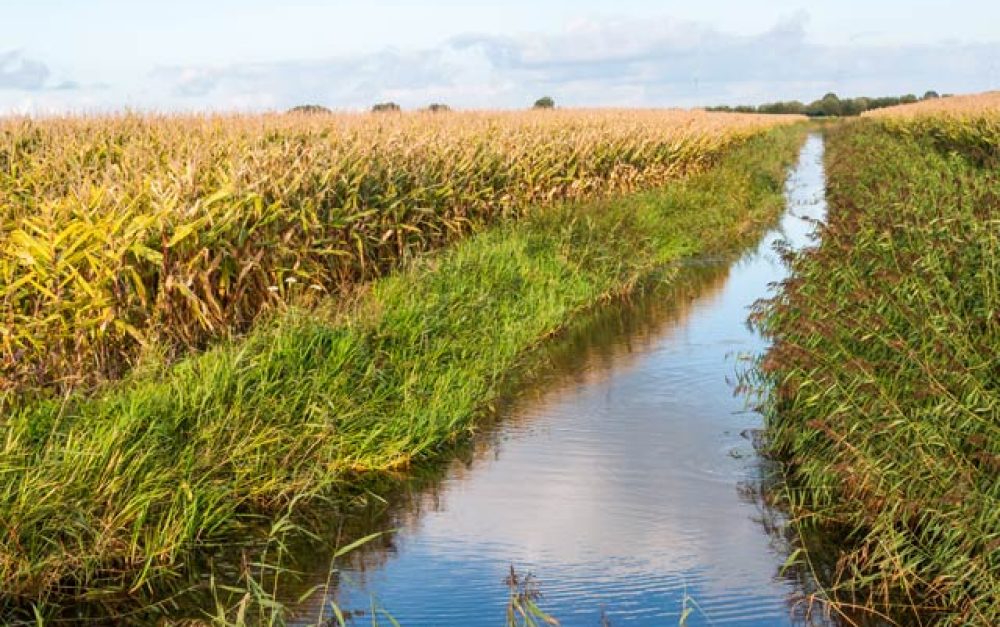What, you may ask, is the “spring flush?” In late spring and early summer, large concentrations of herbicides are flushed from croplands. These chemicals — like the herbicide atrazine — then get transported far and wide through surface water systems.
Herbicides are water-soluble and thus have the potential to leach into groundwater supplies as well as streams, lakes and other surface waters. Atrazine is a frequently found contaminant in drinking water supplies throughout the Corn Belt, and every year the spring flush raises concerns over the potential of atrazine spikes in drinking water supplies.
Commodity crops are planted in the spring, and many of the acres planted are subjected to a herbicide application to clear weeds before planting, or before the plants emerge. The herbicide goes on the ground, but it doesn’t stay there.
You can think of the spring flush as pulses of agrichemicals moving through streams and rivers, with the timing of these pulses heavily influenced by rainfall. More rain for sustained periods of time will wash more of the pre-plant herbicides off the fields.
We already know that atrazine (among other pesticides) contaminates surface waters, groundwater and drinking water throughout the Midwest. Transport of pesticides from fields to waterways and groundwater has been modeled by the U.S. Geological Survey (USGS) as well as documented in USGS surveys.
Should atrazine be in your water glass?
It should be noted that even if highly contaminated surface water enters a water utility, the water leaving the utility may not be highly contaminated. But the fact is, atrazine is too often found in drinking water supplies at levels that exceed EPA’s regulatory standard, or maximum contaminant level (MCL) of three parts per billion.
EPA has made it a priority to monitor atrazine levels in certain community water systems in regions where the herbicide is used. Atrazine may cause more problems for smaller water utilities, because they likely have less capacity and funding to do regular monitoring — and fewer funds to deal with removing atrazine from drinking water supplies when they find it.
In 2010, Midwest water utilities sued Syngenta, atrazine’s maker, for costs incurred by treating water contaminated with atrazine — and won. Syngenta settled with the utilities for $105 million, with each utility receiving payouts to cover their cleanup costs. Keeping in mind that $105 million is a drop in the bucket for a giant corporation like Syngenta, this was still an important victory.
Yet atrazine continues to contaminate surface water each spring, and water utilities are still dealing with the contamination. For both water utilities and individual households, activated carbon filters appear to be the most effective way to remove atrazine from drinking water. But this costs too.
Testing the waters
Programs like Lil’ Miss Atrazine engage community members in environmental monitoring for atrazine in Midwest surface waters during times of intensive atrazine use, mostly in Illinois. Last year, they took samples across Illinois on June 7th, and the monitors detected atrazine in surface waters.
PAN monitored for atrazine in Midwest drinking water back in 2012, and the chemical showed up in 64% of the samples taken in communities in Illinois, Nebraska, Iowa and Minnesota. These samples were taken at around the time of the spring flush, as well.
Levels of exposure in drinking water are likely to be fairly low, and are frequently are found to be below EPA’s MCL. However, there is strong science raising questions as to whether exposure to atrazine is safe even at very “low levels.”
In part, this is because atrazine is a known endocrine disruptor, with studies documenting adverse effects on the development of the male gonad among all of the vertebrate classes — amphibians, fish, mammals, birds, and reptiles. These effects have been found at very low doses (including levels below the EPA’s MCL).
And there’s more. In addition to compelling evidence showing the potential for reproductive health harms, atrazine exposure has been linked to birth defects. In 2011, EPA’s scientific advisory panel cited a link between atrazine and certain types of cancer.
An herbicide that knows no boundaries…
In 2008, USDA found atrazine in 94% of the drinking water tested. EPA’s 2011 scientific advisory panel raised concerns over atrazine-contaminated drinking water supplies that exposed at least three million people.
I could write a lot more about atrazine and why we should be concerned. But I’ll end here with my main take-home points:
- Spring pulses of herbicides into surface water are now predictable, man-made events.
- Atrazine is an endocrine disruptor that contaminates drinking water in areas where it is used – primarily the Midwest.
One last, very important point. A 2013 paper on the benefits of atrazine found that “under Syngenta’s own assumptions, corn growers’ revenues would actually increase by 3.2 percent if atrazine became unavailable.”
Hmm. So tell me again why we’re using this stuff in the first place?








